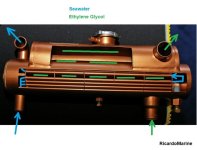Helping a buddy winterize his 2002 and 2018 5.7L 350 MPI, raw water cooled engines. I have fresh water and I know it's a different process.
(2) questions:
After getting to operating temp, removing the thermostat, reinstalling housing, less the thermostat, run engine while running antifreeze through his drive until pink shows at exhaust - will that ensure the engine is void of water and properly winterized ( in terms of freezing ) ?
His fuel lines are robust and a hassle to remove and tap into for the auxiliary fuel tank/ cocktail. Is it OK to use the water/ fuel separator method ? And , if so, what is the mix, and the process ? Do you just let it run through for 5 minutes or so ?
Thx -
(2) questions:
After getting to operating temp, removing the thermostat, reinstalling housing, less the thermostat, run engine while running antifreeze through his drive until pink shows at exhaust - will that ensure the engine is void of water and properly winterized ( in terms of freezing ) ?
His fuel lines are robust and a hassle to remove and tap into for the auxiliary fuel tank/ cocktail. Is it OK to use the water/ fuel separator method ? And , if so, what is the mix, and the process ? Do you just let it run through for 5 minutes or so ?
Thx -



